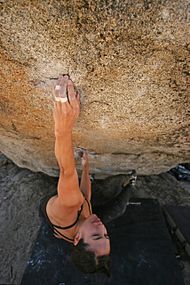
Back بولدرنق Arabic Боўлдэрынг Byelorussian Escalada de blocs Catalan Bouldering Czech Bouldering Danish Bouldern German Búlder Spanish Bloke-eskalada Basque Boulderointi Finnish Bloc (escalade) French
| Part of a series on |
| Climbing |
|---|
 |
| Lists |
| Types of rock climbing |
| Types of mountaineering |
| Other types |
| Key actions |
| Key terms |
Bouldering is a form of free climbing that is performed on small rock formations or artificial rock walls without the use of ropes or harnesses. While bouldering can be done without any equipment, most climbers use climbing shoes to help secure footholds, chalk to keep their hands dry and to provide a firmer grip, and bouldering mats to prevent injuries from falls. Unlike free solo climbing, which is also performed without ropes, bouldering problems (the sequence of moves that a climber performs to complete the climb) are usually less than six metres (20 ft) tall. Traverses, which are a form of boulder problem, require the climber to climb horizontally from one end to another.[1] Artificial climbing walls allow boulderers to climb indoors in areas without natural boulders. In addition, bouldering competitions take place in both indoor and outdoor settings.[2]
The sport was originally a method of training for roped climbs and mountaineering, so climbers could practice specific moves at a safe distance from the ground. Additionally, the sport served to build stamina and increase finger strength. Throughout the 20th century, bouldering evolved into a separate discipline.[3] Individual problems are assigned ratings based on difficulty. Although there have been various rating systems used throughout the history of bouldering, modern problems usually use either the V-scale or the Fontainebleau scale.
The growing popularity of bouldering has caused several environmental concerns, including soil erosion and trampled vegetation, as climbers often hike off-trail to reach bouldering sites. This has caused some landowners to restrict access or prohibit bouldering altogether.
- ^ Cite error: The named reference
Access2006was invoked but never defined (see the help page). - ^ See The Boulder: A Philosophy for Bouldering (Stone Country Press) Archived 16 August 2013 at the Wayback Machine, by Francis Sanzaro, for a more on bouldering movement, and its relation to other sports. I also found this article from Sanzaro on bouldering philosophy and landscape, called "When the Earth Enters You – Movement Aesthetics."
- ^ Hill, Pete (2008). The Complete Guide to Climbing and Mountaineering. Cincinnati: David & Charles. p. 94. ISBN 978-0-7153-2842-2.
© MMXXIII Rich X Search. We shall prevail. All rights reserved. Rich X Search